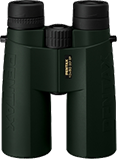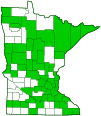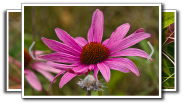eastern parson spider
(Herpyllus ecclesiasticus)
Conservation • Description • Habitat • Biology • Distribution • Taxonomy
|
|
||||||||||||||
Description |
Eastern parson spider is a common, small to medium-sized, ground spider. It occurs in the United States and southern Canada east of the Rocky Mountains and in Mexico. It is common in Minnesota. It is found in deciduous forests and woodlands on the ground under stones and logs. It is also found in buildings. The female is ¼″ to ⅜″ (6.6 to 9.0 mm) in length and has a ½″ to 1″ (12 to 25 mm) legspan. The body is very dark, appearing black at first glance, with distinctive white markings that are said to resemble the vestments of a parson. This is the feature that gives the spider its common name. The front part of the body (cephalothorax) is oval and longer than wide but shorter than the abdomen. The upper side (carapace) is dark blackish-brown with a broad, white, longitudinal stripe in the middle (middorsal). It is covered with short, dark, recumbent hairs. There are eight eyes in two rows of four. Both rows are nearly straight. When viewed from the front, the front (anterior) row is slightly curved forward and the rear (posterior) row is slightly curved backward. When viewed from above, the anterior row is slightly curved backward and the posterior row is straight. The eyes in each row are evenly spaced. The anterior median eyes (AME) are dark, circular, and larger than all of the others. The posterior median eyes (PME) are oval, angled, and a little smaller than the posterior lateral eyes (PLE). The jaws (chelicerae) are brown. They have three or four teeth on the forward facing margin and a single small tooth on the rearward facing margin. The underside of the cephalothorax is orange mottled with brown, and is covered with long erect hairs. The abdomen is long and slightly flattened. The upper side is dark gray to dark brown and is covered with silky gray hairs. There is a broad white or pinkish longitudinal stripe on the basal two-thirds and a white or pinkish spot at the rear. The stripe is slightly narrowed near the one-third point, abruptly and sharply narrowed at the two-thirds point, and broadly crescent shaped at the rear. The front silk-spinning organs (spinnerets) at the rear of the abdomen are long, cylinder-shaped, and visible from above. The legs are stout, medium long, nearly equal in length, and spiny. The third segment (femur) is the same color as the carapace. The remaining segments are brown, sometimes appearing black due to a dense covering of black hairs. There are two claws at the end of each leg, but these cannot be seen without magnification. The male is similar but much smaller, 3 ⁄16″ to ¼″ (4.6 to 6.1 mm) in length. |
Size |
Female Body Length: ¼″ to ⅜″ (6.6 to 9.0 mm) Male Body Length: 3 ⁄16″ to ¼″ (4.6 to 6.1 mm) Legspan: ½″ to 1″ (12 to 25 mm) |
Web |
A silken tube-shaped retreat is made under a rock where the spider will stay during the day, but no hunting web is constructed. |
Similar Species |
Western parson spider (Herpyllus propinquus) is identical in appearance and can be distinguished only by examining the male genitalia under a microscope. Its range does not extend into Minnesota. |
Habitat |
Deciduous forests and woodlands, buildings |
Biology |
Season |
April to October |
Behavior |
Adults hunt at night and spend the day in a silken retreat. They move very fast. |
Life Cycle |
Young spiders overwinter in a silken cocoon under bark. Adults also overwinter. |
Food |
|
Distribution |
||
|
Sources Platnick, N. I. & Shadab, M. U. (1977b). A revision of the spider genera Herpyllus and Scotophaeus (Araneae, Gnaphosidae) in North America. Bulletin of the American Museum of Natural History 159: 1-44. |
|
| 10/10/2024 | ||
Occurrence |
||
Common |
||
Taxonomy |
|
Class |
|
Order |
|
Suborder |
Araneomorphae (Typical Spiders) |
Infraorder |
Entelegynae |
Zoosection |
RTA clade (RTA Clade Spiders) |
Zoosubsection |
Dionycha clade spiders |
Superfamily |
Gnaphosoidea |
Family |
Gnaphosidae (stealthy ground spiders) |
Subfamily |
Herpyllinae |
Genus |
Herpyllus |
Subordinate Taxa |
|
|
|
Synonyms |
|
Drassus vasifer Herpyllus cratus Herpyllus vasifer Melanophora bimaculata Prosthesima bimaculata Prosthesima ecclesiastica Zelotes bryanti |
|
Common Names |
|
eastern parson spider parson spider |
|
Glossary
Carapace
The hard, upper (dorsal), shell-like covering (exoskeleton) of the body or at least the thorax of many arthropods and of turtles and tortoises. On crustaceans, it covers the cephalothorax. On spiders, the top of the cephalothorax made from a series of fused sclerites.
Cephalothorax
The front part of the body of various arthropods, composed of the head region and the thoracic area fused together. Eyes, legs, and antennae are attached to this part.
Chelicerae
The pair of stout mouthparts, corresponding to jaws, in arachnids and other arthropods in the subphylum Chelicerata.
Visitor Photos |
||
Share your photo of this arachnid. |
||
This button not working for you? |
||
Luciearl |
 |
Found on my car door. |
Angela Olson |
 |
I found the spider on my wall in the bathroom. |
Angela Garrett |
 |
MinnesotaSeasons.com Photos |
||
|
||
|

Visitor Videos |
||
Share your video of this arachnid. |
||
This button not working for you? |
||
|
Other Videos |
||
Herpyllus Ecclesiasticus (Parson Spider) - Quick Enclosure |
About
Jul 22, 2017 This Parson spider gave me quite the scare when I went to use the restroom haha. I quickly put together a temporary enclosure for it until I could make something nice. Hope you enjoy. Science Info - https://spiderid.com/spider/gnaphosidae/herpyllus/ecclesiasticus/ |
Parson Spider Herpyllus ecclesiasticus Hentz, 1832 Eating a Fly |
About
Jun 24, 2017 The Eastern Parson Spider eating a fly these hide under rocks and other debris on the ground, sometimes roaming through short grass or along your foundation, or when you flip a board in your yard. They are very FAST!!! YES, you can find them also inside your home, want your kids to clean their rooms? Just share with them that the Parson spider often hides out under clothes left lying on the floor! My daughter never cleaned her room so fast! Gets its name from the striping down the back/abdomen much like a minister's necktie. If you want to catch one, be ready when you turn over flat rocks, loose boards or old tree bark. This adult is about 1/4" in length, they often lay flat and can go right under your bathroom door. Enjoy :) ! This spider was photographed in a petri dish, here is a link to the dishes I use: https://goo.gl/HongcU |
Herpyllus ecclesiasticus Eastern Parson Spider |
About
May 12, 2012 Herpyllus ecclesiasticus Eastern Parson Spider I trapped in a pint glass, rather large. Mostly harmless. Seemed well mannered. |

Visitor Sightings |
||
Report a sighting of this arachnid. |
||
This button not working for you? |
||
Luciearl |
Location: Fairview Twp. Found on my car door. |
 |
| Angela Olson 7/24/2023 |
Location: Otsego, MN I found the spider on my wall in the bathroom. |
 |
| Angela Garrett 7/21/2021 |
Location: Milaca, MN Male |
 |
MinnesotaSeasons.com Sightings |
||
|

Created: 10/30/2022 Last Updated: © MinnesotaSeasons.com. All rights reserved. |


